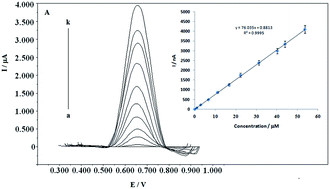Development of a novel voltammetric sensor for the determination of methamphetamine in biological samples on the pretreated pencil graphite electrode†
Abstract
An electrochemical sensor was developed for determining methamphetamine (MA) using an electrochemically pretreated pencil graphite electrode (PPGE). A potentiostatic strategy was employed for electrochemical pretreatment of the electrode. The PPGE displayed very good electrochemical catalytic activity compared with a non-pretreated PGE (NPGE). Using the PPGE, a well-defined anodic peak of MA was observed at about 0.74 V per SCE (in pH 11 solution). There is a very weak oxidation peak with NPGE at the same MA concentration. Pretreatment of a polished PGE by a potentiostatic procedure at 1.70 V for 10 min in 0.1 M Britton–Robinson buffer solution of pH 11 was proposed as the optimum pretreatment procedure. The kinetic parameter charge transfer coefficient, α, was determined for MA at PPGE. In optimum experimental conditions, differential pulse voltammetry (DPV) was used for determining MA, which exhibits a linear calibration graph of Ip versus MA concentration in the range 0.074–54 μM with a correlation coefficient of 0.999. The calculated detection limit for S/N = 3 was 50 nM. Finally, using the standard addition procedure, PPGE was used for determining MA in biological samples such as human serum and urine. The results were promising.


 Please wait while we load your content...
Please wait while we load your content...